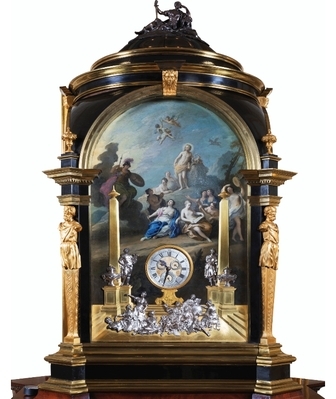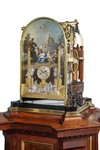Details
TitleLongcase Clock with Organ Playing Movement 'Clay'
Creator Charles Clay (watchmaker), Jacopo Amigoni, Jan Michiel Rijsbrack (beeldhouwer)
PlaceLondon (England), London (England), London (England)
Year ca. 1738
Object number1335
Object nametimepiece with organ pipes, longcase clock
DescriptionThe ten short melodies played by this clock are programmed on a large brass cylinder. The clock has a rather small dial and is decorated in great detail. There are brass, gilt and bronze elements. The silver reliefs are attributed to sculptor Jan Michiel Rysbrack (1684-1770) and the oil painting of a mythological scene (a depiction of Apollo, the nine muses, and Minerva on Mount Parnassus) attributed to painter Jacopo Amigoni (1682-1752). The clock is so luxuriously decorated on all sides that it was most likely intended to be placed in the center of a room so that it could be admired from every angle.
Accompanying textsThe imposing organ work placed inside the clock can play a melody every three hours or on demand. Not all of the ten melodies on the original cylinder are known. What is certain, however, is that the clock plays repertoire by G.F. Handel (1685-1759). For example, the first tune is the "Minuet from the Overture of Arianna," taken from the opera of the same name first performed in 1793. Handel was already a hugely popular composer in his own time. Along with Amigoni and Rysbrack, who had also collaborated on the scenography of his operas in London, the fact that this clock contained music by Handel contributed to the prestige of this luxurious object. The way musical ornaments are programmed on the cylinder gives the clock another level of historical importance. It gives an impression of how this type of music would have been performed in the 18th century and is therefore a valuable source of information. And the unknown melodies are at least as interesting, as a record of music that may not have been heard by many people in a long time.
After clockmaker Charles Clay settled in London in 1720, he was appointed "Clockmaker to His Majesty's Board of Works" at the English royal court in 1723. In this capacity he worked, until his death in 1740, on an impressive series of organ clocks. These are still among the absolute best England has ever produced in this field. Seven examples by his hand are still known today, which are in both museum and royal collections in Europe and China. These other clocks by Clay tend to be somewhat smaller, though, and not all of them have a playing interior anymore. As monumental, original and complete a clock as the one in Museum Speelklok has not been discovered. For whom this impressive clock was originally made is not known. We do know that around 1747 the clock was for sale in Amsterdam in the store of the English clockmaker Roger Dunster. From at least 1759 - and perhaps earlier - the clock came into the possession of Gerrit Braamcamp (1699-1771). His art collection, which included this clock, was known throughout Europe and was visited, for example, by Frederick II of Prussia and William V with his wife. After Gerrit Braamcamp's death, the clock was sold at auction for 3700 guilders to his cousin in Portugal. After this, several unknown owners followed until the clock finally came into the possession of French collector Robert de Balkany in 1972. To distinguish between the multiple known clocks by Clay, we also refer to the one at Museum Speelklok as the "Braamcamp clock". This 'nickname' is refers to the previous ownership by Gerrit Braamcamp.
After clockmaker Charles Clay settled in London in 1720, he was appointed "Clockmaker to His Majesty's Board of Works" at the English royal court in 1723. In this capacity he worked, until his death in 1740, on an impressive series of organ clocks. These are still among the absolute best England has ever produced in this field. Seven examples by his hand are still known today, which are in both museum and royal collections in Europe and China. These other clocks by Clay tend to be somewhat smaller, though, and not all of them have a playing interior anymore. As monumental, original and complete a clock as the one in Museum Speelklok has not been discovered. For whom this impressive clock was originally made is not known. We do know that around 1747 the clock was for sale in Amsterdam in the store of the English clockmaker Roger Dunster. From at least 1759 - and perhaps earlier - the clock came into the possession of Gerrit Braamcamp (1699-1771). His art collection, which included this clock, was known throughout Europe and was visited, for example, by Frederick II of Prussia and William V with his wife. After Gerrit Braamcamp's death, the clock was sold at auction for 3700 guilders to his cousin in Portugal. After this, several unknown owners followed until the clock finally came into the possession of French collector Robert de Balkany in 1972. To distinguish between the multiple known clocks by Clay, we also refer to the one at Museum Speelklok as the "Braamcamp clock". This 'nickname' is refers to the previous ownership by Gerrit Braamcamp.
Digital references



